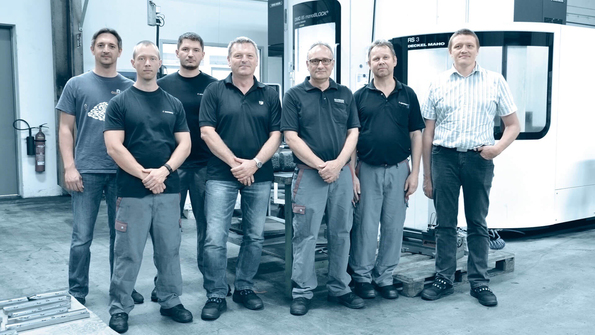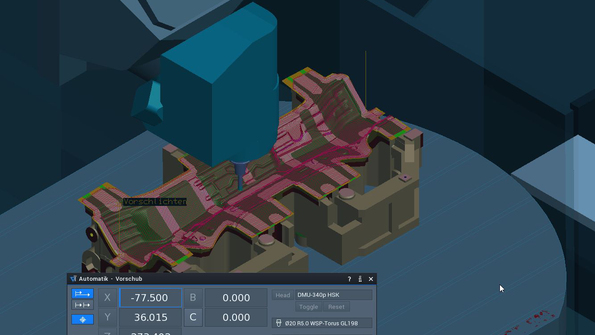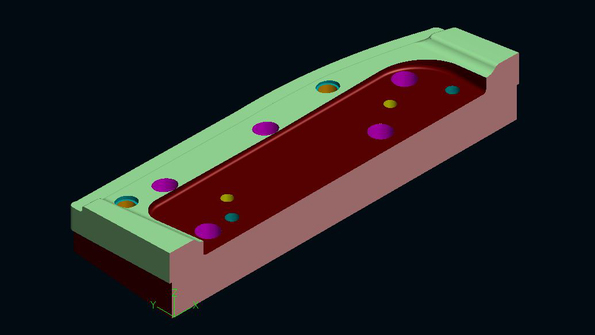-
Software
-
CAM software
- Tebis Automill
- CNC programming
- CNC automation
- CNC simulator
- Multiple setup
- Robotic machining
- CNC drilling
- Deep-hole drilling
- Combined turn-milling
- CNC turning
- Turn-milling
- 2.5D milling
- 3D milling
- 5-axis milling
- Slot milling
- Trimming
- HPC milling
- HFC milling
- Circle-segment cutters
- Sinker EDM
- Wire EDM
- 3D laser cutting
- Laser hardening
- Laser weld cladding
- CAD software
- CAQ software
- MES software
- Products
-
CAM software
- Services
- Consulting
- Sectors
- References
- Company
- News

-
 Home References
Home ReferencesHeinz Schwarz GmbH & Co. KG – Clearly thrilled and measurably improved
Company
Heinz Schwarz GmbH & Co. KG
Location
Preußisch Oldendorf, Germany
Sector
Die manufacturing
Published
2018

Tebis provides comprehensive process consulting and has precise knowledge of our industry. No one else can offer this combination.
Diedrich Diedrichsen, Managing partner, Heinz Schwarz GmbH & Co. KG, Preußisch Oldendorf, GermanyWe all like to talk about the golden rules of business success. Some rely on solid data and clear structures, while others prefer to stick with the "gut feeling" of an experienced workforce. Die manufacturer Heinz Schwarz GmbH & Co. KG in Preußisch Oldendorf has managed to reconcile both factors – with the result that the company has been able to enormously increase its productivity in small parts machining since 2016.
When Heinz Schwarz decided to start his own business in 1964, he found everything he needed to get started right there on his parents' property: The garage and henhouse were quickly converted to a shop and office. But the pragmatic young man could hardly have dreamed at that time that the company bearing his name would become one of the largest independent die manufacturers in Germany – with its roughly 300 employees, the company has now established itself as a reliable partner for the automotive industry, commercial vehicle manufacturing and agriculture. In addition to classic die manufacturing, it offers complete development, all the way to series manufacturing. Such an accomplishment requires perseverance. The 2008 financial crisis was certainly the most severe test Heinz Schwarz GmbH has had to undergo to date. The family business was close to the end at that time.
Navigating the crisis
First-class products, a stable customer base and especially a team of experienced and well-trained specialists, however, led a group of investors headed by Oliver Kesseböhmer to firmly believe in the future of the company. In early 2013, the consortium acquired all business areas and provided the new managing directors, Diedrich Diedrichsen and Henrik Minnich. Much was done in the following years to return the company to success: Schwarz GmbH invested many millions in a tryout center and acquired new machines for small parts manufacturing. Starting in 2015, the focus was especially on improving processes in small parts manufacturing.
 This can't be done without a motivated team…
This can't be done without a motivated team…Gut feeling meets data
Initially, the key was to reconcile solid data with the "gut feelings" of the participants. "We were all in agreement that everything was taking too long," recalls Anne Theile-Wielage, division manager for Mechanical Manufacturing. "Active surface design took too long, NC programming took too long, setup took too long, machining took too long and the machines were standing idle too frequently. But in terms of “why,” opinions diverged." What was missing was a set of data that everyone could understand. An objective outside perspective is especially useful in such situations.
An outside perspective
Schwarz GmbH has relied on Tebis CAD/CAM software for 2.5D and 3D programming since 1995. One reason for this is the large number of available milling strategies that contribute to successful milling quality: Because Schwarz has specialized increasingly in the visible parts of the vehicle over the course of time, a high surface quality is absolutely essential. Tebis also provides many possibilities for transparently storing machining information in the system, thereby making it accessible to all employees. The die manufacturer has also benefited from the advantages of Tebis morphing technologies since 2011. When it came to bringing an objective partner on board to optimize the processes, the choice was Tebis. Diedrichsen remarks, "Tebis provides comprehensive process consulting and has precise knowledge of our industry. No one else can offer this combination." What followed was an unmatched joint project management that ended with clearly measurable results.
Process standardization and productivity in the small parts process
"In the first project, 'Process standardization and productivity in the small parts process,' we especially wanted to reduce the time input by employees and enable multiple machine operation," Theile-Wielage summarizes. The project, divided into three project phases, "Analysis and assessment," "Implementation" and "Conclusion and evaluation", ran from September 2015 until March 2016.
Working with Tebis, discussions were conducted across departments to analyze what fit with which process steps and to find weaknesses and determine where potential existed. "It quickly became clear that we had to take action in active surface design and NC programming if we wanted to make any improvements," says the division manager. "Small parts preparation was extremely cumbersome. And there were umpteen different templates in programming – the programmers and machine operators had to constantly discuss."
Clear milestones and responsibilities
As a result, clear and realistic goals were set and assigned to subprojects, along with milestones and responsibilities. The goal was to significantly reduce the expenditure for preparing the exact solids and for NC programming. At the same time, the aim was to improve parallel setup. These tasks could in turn be linked to specific measures. Keywords here are preparation of the small parts in exact solids with Tebis, consistent use of Tebis simulation, automation of 2.5D machining with variable features as well as programming with standardized templates and process libraries. To make the changes measurable, actual conditions were recorded at the start of the project.
 Tebis simulation methods are also used in planning. The indicated calculation times in the small parts process are accurate down to the minute, kinematics and tool-specific cutting data are fully applicable in practice – these are all essential prerequisites for manufacturing with less employee effort, including nights and weekends.
Tebis simulation methods are also used in planning. The indicated calculation times in the small parts process are accurate down to the minute, kinematics and tool-specific cutting data are fully applicable in practice – these are all essential prerequisites for manufacturing with less employee effort, including nights and weekends.Goals surpassed
The overall project was very carefully documented. The individual steps could thus be reliably evaluated. Theile-Wielage is delighted: "We have since far exceeded our initial goals. This is the case for small parts preparation and NC programming as well as for parallel setup; reduced-personnel manufacturing and multiple machine operation have also since become a fixed element of small parts production."
The expenditure for preparing the exact solids and for NC programming were also significantly reduced. "We now produce roughly 70 percent of the small parts from solid material using templates," Theile-Wielage says. "The proportion of parallel setup has also been increased. We have noticeably reduced the employee effort required for the product. This has an immediate effect on throughput: We now produce at least 50 percent more parts compared to 2015, when we started the small parts project. And this development is continuing."
Front-loading active surface
Since productivity was so greatly improved in the small parts process, the company also embarked on optimizing the large parts process in active surface design in the summer of 2016. Stefan Ardelt, division manager for Engineering and Design, says: "Up to that point, we had only used Tebis for overbending in Design; now we wanted to use the software for the entire active surface design." In this context, "front-loading with active surface preparation" means designing sheet metal thinning, pressure and spot facing surfaces as well as all radii directly in the active surface – NC programming now uses exact active surfaces that are matched and optimized for the use of each individual part. Now only six employees design the active surfaces – using Tebis exclusively.
The entire process chain at a glance
Just how important cooperation across departments is becomes especially clear again here: "What happens in the active surface has a very high effect on the downstream process steps," Ardelt says. "Even if active surface preparation initially takes somewhat longer – the time requirement for programming and especially for fitting the die in tryout is so greatly reduced that, in general, it has already yielded a positive result on the bottom line. With Tebis' industry expertise, we were able to improve overall die quality. The surfaces are so precise, machining with efficient HFC tools is no problem. We will continue to work together and make adjustments in order to become even more efficient."
 Active surface and solid geometry can be combined in a single part with the "Exact Solid Preparation" add-on. Similar parts are combined in categories for which automated NC programs can be created.
Active surface and solid geometry can be combined in a single part with the "Exact Solid Preparation" add-on. Similar parts are combined in categories for which automated NC programs can be created.
